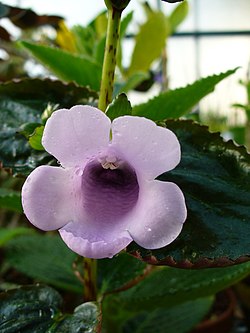Gloxinia (genus)
Jump to navigation
Jump to search
| Gloxinia subsp. var. | ||||||||||||||||||||||||||||||||||||||||||||||||||||||||
|---|---|---|---|---|---|---|---|---|---|---|---|---|---|---|---|---|---|---|---|---|---|---|---|---|---|---|---|---|---|---|---|---|---|---|---|---|---|---|---|---|---|---|---|---|---|---|---|---|---|---|---|---|---|---|---|---|

|
|
| ||||||||||||||||||||||||||||||||||||||||||||||||||||||
| ||||||||||||||||||||||||||||||||||||||||||||||||||||||||
- If you're looking for the popular flowering houseplant known as Gloxinia, see Sinningia speciosa.
Gloxinia is a genus of three species of tropical rhizomatous herbs in the flowering plant family Gesneriaceae. The species are primarily found in the Andes of South America but Gloxinia perennis is also found in Central America and the West Indies, where it has probably escaped from cultivation.
Cultivation
Propagation
Pests and diseases
Species
- Gloxinia perennis has a wide range in Central and South America. The plant is an herb with large nodding, purple, mint-scented flowers. It is sometimes known as "Canterbury Bells" (not to be confused with members of the genus Campanula, which go by the same name). It is cultivated in tropical regions and its original range is unknown.
- Gloxinia erinoides (syn. Koellikeria erinoides) occurs from Costa Rica to Bolivia. The plant is a small herb with tiny white and maroon flowers. This diminutive plant is notable for having tiny but distinctly coconut-scented flowers and is occasionally cultivated as a houseplant.
- Gloxinia xanthophylla (syn. Anodiscus xanthophyllus) occurs in Ecuador and Peru. The plant is a shrubby herb with small white flowers and is rarely encountered in cultivation. Unlike the other two species it lacks scaly rhizomes.
- Excluded species
- Gloxinia burchellii = Sphaerorrhiza burchellii
- Gloxinia dodsonii = Nomopyle dodsonii
- Gloxinia gymnostoma = Seemannia gymnostoma
- Gloxinia ichthyostoma = Mandirola ichthyostoma
- Gloxinia lindeniana = Gloxinella lindeniana
- Gloxinia nematanthodes = Seemannia nematanthodes
- Gloxinia planalta = Mandirola multiflora
- Gloxinia purpurascens = Seemannia purpurascens
- Gloxinia racemosa = Gloxiniopsis racemosa
- Gloxinia reflexa = Monopyle reflexa
- Gloxinia rupestris = Mandirola rupestris
- Gloxinia sarmentiana = Sphaerorrhiza sarmentiana
- Gloxinia speciosa = Sinningia speciosa
- Gloxinia sylvatica = Seemannia sylvatica
Gallery
-
photo 1
-
photo 2
-
photo 3
References
External links
- w:Gloxinia (genus). Some of the material on this page may be from Wikipedia, under the Creative Commons license.
- Gloxinia (genus) QR Code (Size 50, 100, 200, 500)
